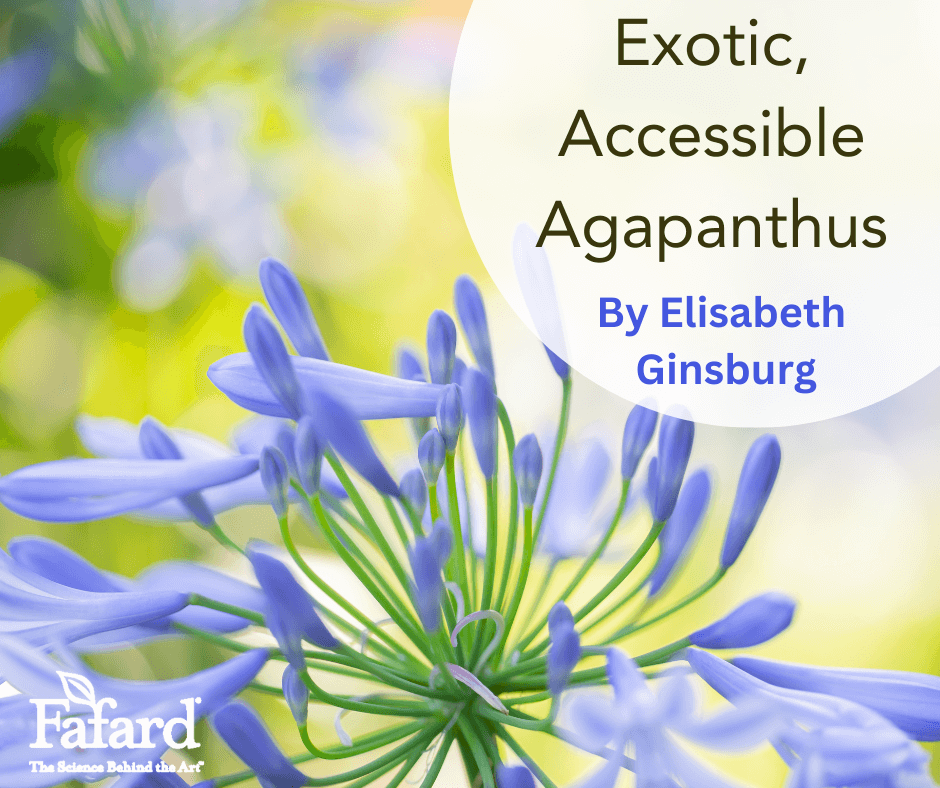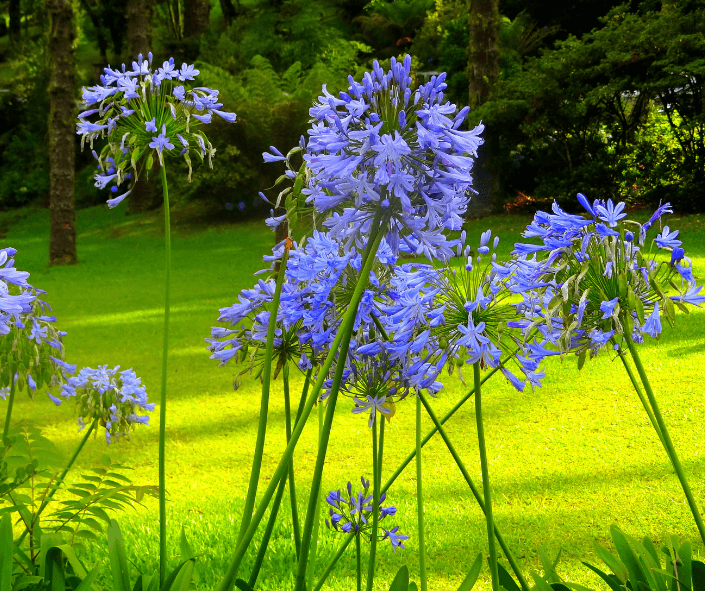
Brides traditionally wear or carry “something old, something new, something borrowed, and something blue.” Gardens—whether they are arrays of containers, in-ground beds, or window boxes–often contain those same elements. Agapanthus, sometimes known as “Lily of the Nile”, combines all of those attributes in a single plant. The “something old” is Agapanthus africanus, an ancestor of today’s varieties, which appeared in Europe as early as the seventeenth century, but is native to South Africa. “Something new” describes the many new agapanthus hybrids that feature increased bloom size, a broadened color range, and more compact size. “Something borrowed” is the “Nile” in the common name, which has persisted, though the plants have nothing to do with that great river. The “something blue” refers to the most common flower color.
With all those sterling qualities, plus the ability to flourish equally well in the ground or in containers, agapanthus marries the exotic and the accessible, with beautiful results.
An Onion Cousin
The genus is part of the Alliaceae or onion family, but its growth habit might remind you a little of holiday amaryllis (Hippeastrum), with tall, fleshy stalks and long narrow leaves. Those stalks generally grow between 18 inches and four feet tall, depending on variety, on plants that spread of at least 1 foot. The rounded flowerheads or umbels appear at the tops of the stalks and are made up of scores of trumpet-shaped florets, which appear in shades of blue and blue-purple, as well as white. You can buy varieties of Agapanthus africanus from some vendors, but most commercially available agapanthus plants are hybrids. The number of those hybrid varieties has increased steadily over the years, with new generations of agapanthus hybrids succeeding older ones.
Beautiful Tender Perennial

Given its origins in the southern hemisphere, it is not a surprise that agapanthus is classed as a tender perennial that is only marginally hardy in cold winter climates. New varieties are more cold-tolerant than older ones, but all can be overwintered successfully. Some varieties feature evergreen leaves.
Blue and White Hues
If you like blue, you can choose a light blue variety like ‘Summer Skies’, which also has the benefit of being cold hardy to USDA plant hardiness Zone 6. For brighter blues, choose tall ‘Blue Yonder,’ or the slightly shorter (24 inches) ‘Kingston Blue’. If you want dramatic dark blues, go for ‘Black Buddhist’, with dark purple buds and dark blue-purple florets, or ‘Back in Black’ with dark flowers and black-streaked stalks. The extremely floriferous ‘Storm Cloud’, also bears umbels of highly saturated blue-purple.
Cool white cultivars include ‘Cold Hardy White’, which is hardy to USDA plant hardiness zone 5, and bears white florets on 12- to 16-inch stalks. Somewhat taller, at over three feet ‘Galaxy White’ is hardy to USDA zone 6,
Double the Fun

Little ‘rfdd’ Double Diamond grows to only about 12 inches tall but makes up for its short stature with umbels of double or semi-double white blooms. It is not terribly cold-hardy but is eminently suitable for container culture and overwintering in cold winter climates.
Sun and Soil
No matter what variety you choose, plant the rhizomes just below the surface of the soil. If you buy container-grown agapanthus and want to transplant to a decorative pot or tub, make sure the top of the soil surrounding the plant is on level with the top of the soil in the chosen container. Situate your plant in a sunny location with some afternoon shade, if possible.
Agapanthus bloom best when they are slightly potbound, so select an appropriately-sized container. Use a quality potting mix like Fafard Ultra Container Mix with Extended Feed, and make sure the agapanthus has consistent moisture. Fertilize with a balanced plant food, diluted according to manufacturer’s directions, during the spring and summer growth period.
A Long Winter Nap
Cold climate dwellers should bring potted agapanthus indoors to a bright, frost-free location for the winter, watering occasionally. When spring returns, take the plants outdoors and begin watering and fertilizing once again.
Opulence Divided

Brilliant blue or white agapanthus look great as single specimen plants, and opulent when massed in large tubs. Happy plants will form clumps, and you can increase your supplies by digging, lifting and splitting those clumps (with a sharp spade or garden knife), and replanting the divisions. If you share those agapanthus divisions with the gardeners among your friends or neighbors, they will most likely be grateful for the gifts of “something borrowed” and “something blue” from you.

